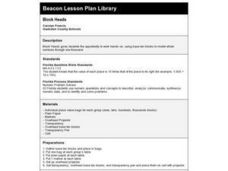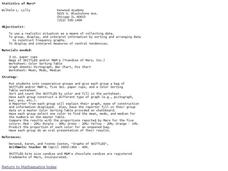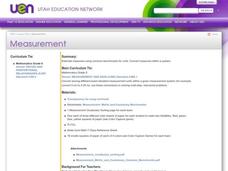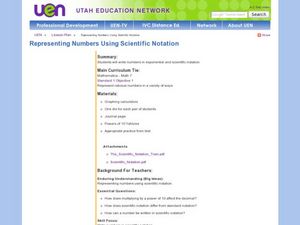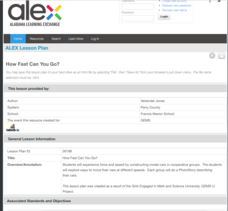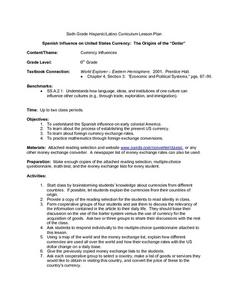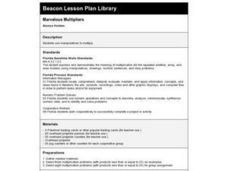Curated OER
Block Heads
Learners demonstrate whole numbers through one thousand using base ten blocks. They model and describe given numbers using ten blocks.
Curated OER
Statistics of Mars
Students explore the concept of central tendencies. In this central tendencies lesson plan, students sort M&M's or Skittles based on color. Students graph their results. Students find the mean, median, and mode of their data.
Curated OER
One Size Fits All, Part 1
Can you tell how tall someone is just by looking at their feet? In this activity, young mathematicians measure their height, arm span, and foot size, graph their findings, and answer questions about how these measurements are related....
Curated OER
You Can Find It!
Students, in groups, use longitude and latitude to locate various places on a map.
Curated OER
Measurement
Students explore the concept of measurement. In this measurement lesson, students discuss what specific measurement tools such as an odometer measure. Students recite a measurement poem. Students make a foldable with conversion units...
Curated OER
Representing Numbers Using Scientific Notation
Learners explore the concept of scientific notation. For this scientific notation lesson, mathematicians discuss how multiplying by a power of 10 affects the decimal. They play Powers of 10 Yahtzee. Students roll a die five times and...
Curated OER
Jobs on a Ship
Students facilitate each student's comprehension of the different jobs on a ship and the job's evolutions over time. They compare/contrast certain jobs on a ship from history to today. Students work together in cooperative groups to...
Curated OER
How Much Do We SPend For Electricity?
Students investigate the concept of energy and focus upon the usage and the cost associated with it. They conduct research using a variety of resources while working in cooperative groups. Students graph the usage of energy as estimates...
Curated OER
Napolean Triangle
Students investigate the Napoleon triangle theory. In this polygon lesson, students differentiate between the boundary points, interior and lattice point of a polygon. They apply concepts of equilateral triangles to solve...
Alabama Learning Exchange
How Fast Can You Go?
Learners investigate force and speed. In this physics instructional activity, students construct model cars in small groups and perform experiments to identify what factors influence speed and force.
Curated OER
Usage and Interpretation of Graphs
Students explore graphing. In this graphing lesson, students predict how many shoe eyelets are present in the classroom. Students count eyelets and work in groups to organize and chart the data collected. Students put all the data...
Curated OER
Exploration with Geometric Solids
Students reinforce geometric concepts by playing "Guess My Solid." Through a process of elimination, they determine the shapes of mystery solids. Finally, students use various materials to construct their own geometric figures.
Curated OER
Spanish Influence on United States Currency: The Origins of the "Dollar"
Sixth graders research the Spanish influence on early colonial America and the process of establishing the present U.S. currency. They read and discuss an informational handout in small groups, and take a short quiz. Students then...
Curated OER
Congruent Triangles
Students explore the concept of congruent triangles. In this congruent triangles lesson, students use Cabri Jr. to construct two congruent triangles using circles. Students determine if the two triangles are congruent by...
Curated OER
What's Your Angle
Students create an original lesson plan about geometry and angles. In small groups they take pictures using a digital camera of obtuse, acute, right, and straight angles that they find at school. Students use the photos in a computer...
Curated OER
Water Density Boundaries
Students create observable layers in water that represent a separation based upon density differences. They model density boundaries using differences in temperature and salinity. They, in groups, perform a meaningful experiment...
Curated OER
Venn Diagram with Blocks
Fifth graders classify blocks according to their attributes. In this math lesson, 5th graders will identify attributes of blocks, sort them, then form the groups into a Venn Diagram, and write ratios using the attributes.
Curated OER
Marvelous Multipliers
Third graders, in groups, solve problems by using counters and drawing counters on paper.
Curated OER
What Does It Take?
First graders study the attributes of circles, squares, triangles and rectangles. They sort shapes that are the same and those that are different into groups.
Curated OER
Chain Across the Hudson
Fourth graders role play as contractors responsible for constructing a chain across the Hudson River. They apply math skills to determine the total weight, number of links, and cost of the project.
Curated OER
Black Bayou Lake Measures Up
Students, in groups, estimate measurments and then select the tools needed and measure various items at Black Bayou Lake refuge.
Curated OER
Phenomenal Weather-Related Statistics
Eighth graders research, collect and interpret data about weather statistics. They record that data on spreadsheets. they create Powerpoint presentations on their individual or group research.
Curated OER
"Weighing the Elephant"
Can your class solve the problem presented in the Chinese folktale, "Weighing the Elephant?" Read your class the description before having them attempt to solve the problem. After they've come up with an answer (or attempted to!), finish...
Curated OER
Matrices at the Speed of Light!
Perform operations using matrices in this algebra lesson. Middle schoolers add, subtract, and multiply matrices. Additionally, they solve systems of equations using matrices.
